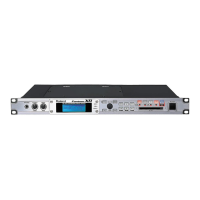90
Creating a Performance
Cutoff Offset
Adjusts the cutoff frequency for the patch or rhythm set assigned to
a part.
Value:
-64– +63
Patches also have a Cutoff Offset setting (p. 49). The final Cutoff
frequency value is the sum of the tone Cutoff Frequency value
and the patch and part Cutoff Offset values. If the tone’s cutoff
frequency is already set to “127” (maximum), there will be no
change produced by setting the Cutoff Offset to a positive
value.
Resonance Offset
Adjusts the Resonance for the patch or rhythm set assigned to a part.
Value:
-64– +63
Patches also have a Resonance Offset setting (p. 50). The final
Resonance value is the sum of the tone Resonance value and the
patch and part Resonance Offset values. If the tone’s resonance
is already set to “127” (maximum), there will be no change
produced by setting the resonance offset to a positive value.
Attack Time Offset
Adjusts the TVA/TVF Envelope Attack Time for the patch or
rhythm set assigned to a part.
Value:
-64– +63
Patches also contain the Attack Time Offset setting (p. 50). The
final TVA Envelope attack time value is therefore the sum of the
tone’s TVA Envelope Time 1 setting, the patch’s Attack Time
Offset, and the part’s Attack Time Offset. If the tone’s Time 1
parameter is already set to “127” (maximum), there will be no
change produced by setting the Attack Time Offset to a positive
value.The same applies to the TVF envelope.
Release Time Offset
Adjusts the TVA/TVF Envelope Release Time for the patch or
rhythm set assigned to a part.
Value:
-64– +63
Patches also contain a Release Time Offset setting (p. 50). The
final TVA Envelope release time value is therefore the sum of
the tone’s TVA Envelope Time 4 setting, the patch’s Release
Time Offset, and the part’s Release Time Offset. If the tone’s
Time 4 parameter is set to “127” (maximum), there will be no
change in the Release Time Offset, even when this is set to a
positive value.The same applies to the TVF envelope.
Decay Time Offset
Adjusts the TVA/TVF Envelope Decay Time for the patch or rhythm
set assigned to a part.
Value:
-64– +63
Mono/Poly
Set this parameter to “MONO” when the patch assigned to the part
is to be played monophonically, or to “POLY” when the patch is to
be played polyphonically. If you want to use the Mono/Poly setting
of the patch assigned to the part (p. 50), set this to “PAT.”
Value:
MONO, POLY, PAT
This setting is ignored for parts to which a rhythm set is
assigned.
Legato Switch
You can add legato when performing monophonically. The term
“legato” refers to a playing style in which notes are smoothly
connected to create a flowing feel. This creates a smooth transition
between notes, which is effective when you wish to simulate the
hammering-on and pulling-off techniques used by a guitarist.
Turn this parameter “ON” when you want to use the Legato feature
and “OFF” when you don’t. If you want to use the Legato Switch
setting of the patch assigned to the part (p. 50), set this to “PAT.”
Value:
OFF, ON, PAT
This setting is ignored for parts to which a rhythm set is
assigned.
Portamento Switch
Specify whether portamento will be applied. Turn this parameter
“ON” when you want to apply Portamento and “OFF” when you
don’t. If you want to use the Portamento Switch setting of the patch
assigned to the part (p. 50), set this to “PAT.”
Value:
OFF, ON, PAT
This setting is ignored for parts to which a rhythm set is
assigned.
Portamento Time
When portamento is used, this specifies the time over which the
pitch will change. Higher settings will cause the pitch change to the
next note to take more time. If you want to use the Portamento Time
setting of the patch assigned to the part (p. 51), set this to “PAT.”
Value:
0–127, PAT
This setting is ignored for parts to which a rhythm set is
assigned.
Fantom-XR_r_e.book 90 ページ 2006年4月4日 火曜日 午前10時14分

